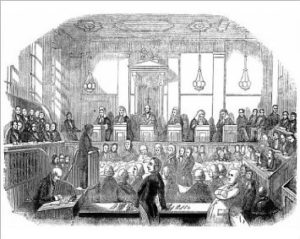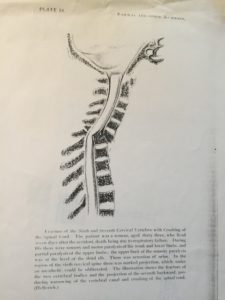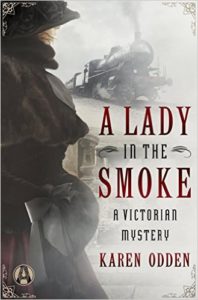An Interview with Author Karen Odden

Law and medicine have had an uneasy marriage.
Sometimes jurisprudence, with a red rose in its teeth, drops on its knees before its lady, asking her to provide crucial expert testimony upon which the outcome of a trial hinges. At other times, it chastises and punishes its partner. The recent case of Michael Jackson’s physician, who faced criminal charges for malpractice, offers an extreme example, but it’s not a new one. The relationship goes back for centuries, and manslaughter charges for medical malpractice pepper the 19th century record.
To understand that relationship, sometimes it helps to look back.
Karen Odden, who wrote her Ph.D. dissertation on topics related 19th century medical jurisprudence — representations of Victorian railway disasters in medical, legal, and popular literature, joins us today for an interview on the rocky Victorian courtship between the two professions. She focused on the emerging concept of trauma in railway disasters and worked her research into a new novel, A Lady in the Smoke. Odden’s story combines Victorian romance and mystery: The heroine must solve a crime to win her love. And that crime is all wrapped up in 19th century medical jurisprudence.
Welcome, Karen!

A pivotal point in the plot of your novel, A Lady in the Smoke, involves manslaughter charges against a doctor for medical malpractice in 1874. What did the doctor do?
In my novel, Sir Lewis Solmes feels justified in accusing a surgeon of this criminal charge because he claims that a railway surgeon was willfully ignoring common practice in refusing to bleed his patient, who died.
Sometimes medical malpractice crosses the line and becomes a crime. What can you tell us about the history of medicine and its intersection with criminal law?
The notion of medical malpractice had been around for a long time—the first recorded case occurred in 1374, involving a mangled hand—as had the notion of “moral culpability,” which depends in part on the notion that a reasonable person recognizes the proper thing to do in a given situation. By the 1870s, there was plenty of public discussion about whether medical men were criminally culpable in cases of death, and whether medical men or the legal courts should have the final word on that. The difficulty was that medical men in the 1870s were operating with insufficient and evolving knowledge—and so the “proper” treatment wasn’t always clear. However, by the late-19th century, there were cases in which doctors were accused and convicted of criminal medical malpractice. For example, in 1889, a scalpel-happy surgeon in Brooklyn was accused and convicted of manslaughter by gross negligence.
According to your book, 19th century medical jurisprudence experienced a surge in the 1850s-1890s. Physicians appeared before the courts in significant numbers to testify about railway-related injuries. Was this the first time the courts had to deal with medical testimony?
Actually, no. In the 1840s, there were trials concerning insanity that brought medical men in significant numbers into the courts for the first time. In some ways, those trials at mid-century, which both shaped and responded to “lunacy reform,” required the significant first wave of medico-legal discourse; the railway injury cases demanded the second.

Tell us about the insanity defense.
The insanity defense became a medico-legal issue around the mid-nineteenth-century. There were several underlying causes for this. In the first third of the 1800s, English courts began to rely more on medical evidence generally; and beginning in the 1830s, medical men and scientists were starting to describe brain function in the way they described other bodily systems.
Then, several critical events in the 1840s brought lunacy reform to the forefront of social concerns. In 1843, Daniel M’Naghten, believing the Prime Minster was out to kill him, tried to kill the PM and shot his secretary instead; following this shocking public event and the murder trial, the M’Naghten Rule was established, which declared that a person could not be found guilty if he was in such a state at the time of committing the crime as to not know what he was doing, or to know what he was doing but not know that it was wrong.
In 1845, two acts—the Lunatics Care and Treatment Act and the Lunatics Asylum Act—anchored a trend toward treating the insane rather than shunting them to the workhouses or prisons. The term “criminally insane” evolved, suggesting both a judicial verdict and a medical diagnosis. (For more on this fascinating subject, see Roger Smith’s book, Trial by Medicine: Insanity and Responsibility in Victorian Trials.)
How did the railway trials affect the law?
In a somewhat parallel process, the new medico-legal category of what some called “railway spine,” later called “traumatic injury” (and still later, PTSD) emerged out of the railway trials. Evolving notions about the body and injury, together with new and shocking events (railway accidents) and new Acts in the late 1840s and 1850s contributed to create a situation where evolving medical jurisprudence had to be tested in courts of law.
And how did the medical profession influence the legal system?
In 1858, the Medical Act joined together apothecaries, apprentice-trained surgeons, and university-trained physicians into one profession. It was an uneasy alliance, to say the least, with medical men pecking at each other in newspapers and pamphlets and the Lancet. Some medical men pleaded for a stop to the squabbling, recognizing that it was only undermining their professional authority to be arguing in public about prognoses and treatments. But the arguments went on—and after 1846, when Lord Campbell’s Act made it possible for individuals to sue the railway companies for injuries, medical men started to appear in the courts to testify about injuries that could not be seen. The problem was that under existing medical jurisprudence, a plaintiff could not obtain money unless an injury was “organic”—that is, locatable in a specific organ. General nervousness, for example, didn’t count.
So sympathetic medical men such as John Eric Erichsen (the mentor of my fictional railway surgeon, Paul Wilcox) wrote books that attempted to prove both that railway accidents existed on a continuum with other accidents (like falling off a horse, say) and that they were unusual in that sometimes they caused injuries that couldn’t be seen. Erichsen and others sometimes located the injury in the spine, positing that the “shaking” of the spinal cord that occurred in railway accidents caused small lesions or cuts in it, which then caused secondary symptoms. Naturally, the spinal cord in a live plaintiff wasn’t available for examination in the courtroom. So the testimony of medical men was crucial in helping the juries to imagine the injury.

In what way did the railway trials shape 19th century medical jurisprudence?
Railway trials were important to the evolution of the medical profession as a whole because they provided a public venue where medical men could raise their public profile and assert their authority. These trials were often sensational dramas, complete with moans and groans, and many of them were reported in the newspapers. So the visibility of the trials was multiplied many times over by the popular press.
How did the role of circumstantial evidence evolve during the 19th century?
Circumstantial evidence found its footing in the 19th century. Under Roman law, conviction of a serious crime required the testimony of two witnesses, and circumstantial evidence was suspect. But by the 19th century, advancements in science gave the courts new respect for indirect evidence, like the bloody handprint on the wall, the footprints in the sand, the smoking gun. New laws allowed courts to based convictions on circumstantial evidence alone, especially in continental Europe.
And how did that affect the railway trials?
The railway injury cases went right along with this trend. A successful case from a plaintiff depended upon what medical men called “objective symptoms” that could not be feigned but, taken all together, proved an internal, invisible injury. These included heightened blood pressure, a mottled look to the skin, unusual pupil dilation, irregular heartbeats, fever, and so on. “Subjective symptoms” — those that were described by a patient — were not proof enough of injury because a patient could lie about ringing in the ears, or headaches, or a sore neck—and there was sufficient financial motivation to do it! In 1865, one plaintiff asked for £23,000 ($2.2 million in today’s money)! He only won a portion of that, but you can see why victims were eager to go to court; why there were plenty of cases of malingering; and why railways increasingly kept medical men on staff, to serve as defense witnesses in these cases.
One of my favorite anecdotes was about a medical man in America named Wharton Sinkler who in 1908 brought a poker into the courtroom; if a plaintiff complained of lack of feeling or paralysis in a limb, he would use it to test their truthfulness. I wasn’t quite truthful myself, inserting him into my 1874 novel, but he was too good to leave out!
Thank you, Karen!

About the author:
Karen Odden is the author of A Lady in the Smoke: A Victorian Mystery (Alibi/Random House), published in March 2016. Her interest in the Victorian era and specifically railway crashes goes back to her New York University doctoral dissertation, which explored how the medical, parliamentary, and literary representations of railway disasters helped to create a discourse out of which Freud and others fashioned their ideas of “trauma.” Karen has taught at the University of Wisconsin-Milwaukee, New York University and the University of Michigan-Ann Arbor. She has contributed essays and chapters to books and journals, including Studies in the Novel, Journal of Victorian Culture, and Victorian Crime, Madness, and Sensation; and she has written introductions for Barnes and Noble’s editions of books by Dickens and Trollope. Prior to earning her Ph.D. in English, she worked as an Editorial Assistant at Harcourt Brace Jovanovich and McGraw-Hill and as a Media Buyer for Christie’s Auction House in New York. She is a member of SCBWI and Mystery Writers of America; and she serves as an Assistant Editor for Victorian Literature and Culture (Cambridge UP). Karen lives in Scottsdale, Arizona with her husband, her two children, and her ridiculously cute beagle, Rosy. She is currently at work on her next novel, set in 1878 London, called Down a Dark River. Visit her website at www.karenodden.com.



